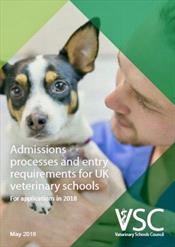

VSC screenshot
The Veterinary Schools Council in London has published a new guide to programs in the United Kingdom.
Hoping to lure Britain’s brightest, the country’s veterinary schools have showcased their programs’ purported benefits and admissions rates in a new publication.
The 27-page document, said to be the first official guide to veterinary degrees in the United Kingdom, was published by the Veterinary Schools Council, a body set up in 2014 to represent the schools’ collective interests. The free guide is posted online.
Entries were composed over a period of months by admissions staff at seven schools: the Royal Veterinary College and the universities of Bristol, Cambridge, Edinburgh, Glasgow, Liverpool and Nottingham.
The country’s eighth and newest veterinary school, at the University of Surrey, hasn’t produced any graduates yet, so it's not in this year’s guide. The document is meant to be updated annually, so Surrey will get a chance to participate after its first batch of students finishes in 2019.
“It’s our hope that collecting course information together makes things easier for candidates as they acquaint themselves with veterinary medicine,” Dr. Ewan Cameron, the council chairperson, said by e-mail.
“The process of applying to such a highly-subscribed degree can be daunting, so this kind of clarity will help show candidates what they can do," Cameron added, "just as it helps us search for the very best candidates.”
The guide’s publication comes as Britain’s vote to leave the European Union, known as Brexit, sparks fears of a skills shortage in the veterinary profession, given that some 25 percent of U.K. practitioners were born on the European mainland.
In an introductory message, VSC Admissions Committee Chair Dr. David Bainbridge says the guide is meant to fill gaps in information often accessed by prospective applicants. "You should, for example, be cautious about what you read on student chatrooms — these are often dominated by particular contributors, and the information provided can be inaccurate," he cautions.
U.S. organizations offer similar resources
"Another factor to consider is that if you ask qualified vets for advice, they will each have experienced the course at just one vet school, and their knowledge of even that will necessarily be some years out of date," the message continues. "Also, entirely understandably, vets tend to promote the vet school where they trained as the best! As a result, it can be difficult for potential applicants to get a full, balanced idea of what the different vet schools offer."
In the guide, apart from advertising the quality of their educational offerings and specialties, many of the schools tout their geographic locations. Bristol, for example, was voted the best place to live in the U.K. last year by The Sunday Times, according to Bristol University’s entry. Cambridge University, for its part, boasts “superb sporting, recreation and academic facilities,” and suggests students will enjoy town life, “whether you’re shopping in the city’s medieval streets or dodging cattle on an idyllic riverside walk.”
The guide also offers aspiring veterinarians an idea of how hard it is to get into each program, by providing applicant-to-placing ratios for each school and detailing interview procedures.
Program costs aren’t mentioned. Government support means out-of-pocket expenses for all U.K. or EU veterinary students are capped at £9,000 (US$12,000) per year. International students from outside the EU, though, have to pay much more. The RVC, for example, charges them about £34,000 (US$45,000) a year. EU students could face higher costs in the future, depending on the outcome of Brexit negotiations.
In the schools guide, placing ratios are broken down to distinguish between applicants who are residents of the U.K. and EU, and those who are not.
Judging from the ratios, the Royal Veterinary College appears to be the easiest to crack: In 2017, there were just three U.K./EU applicants for each place. From those outside the U.K. and EU, there were four applications for each place. The Royal Veterinary College also had the most places available — 270.
For U.K./EU residents, the two schools in Scotland appear to be the toughest to enter: There were 11 applicants for each place at Edinburgh and Glasgow universities.
For aspirants outside of the U.K. and EU, getting into Liverpool University looks to be the most rigorous, with 38 applicants applying for each of the only two places that went to outsiders. (Almost all of the 164 places were offered to U.K. and EU residents.)
However, getting into a school isn’t as hard as any of those numbers would suggest. Each year, there are about twice as many applicants as available places overall, according to the guide. That makes for a one-out-of-two shot at admission.
This is because prospective students typically apply to more than one school at a time.
Dr. David Bainbridge, chair of the VSC Admissions Committee and a veterinary anatomist at Cambridge University, explained, “We assume that all of them apply [to] four, so dividing the total number of applications by four gives a number approximately twice the number of places.”